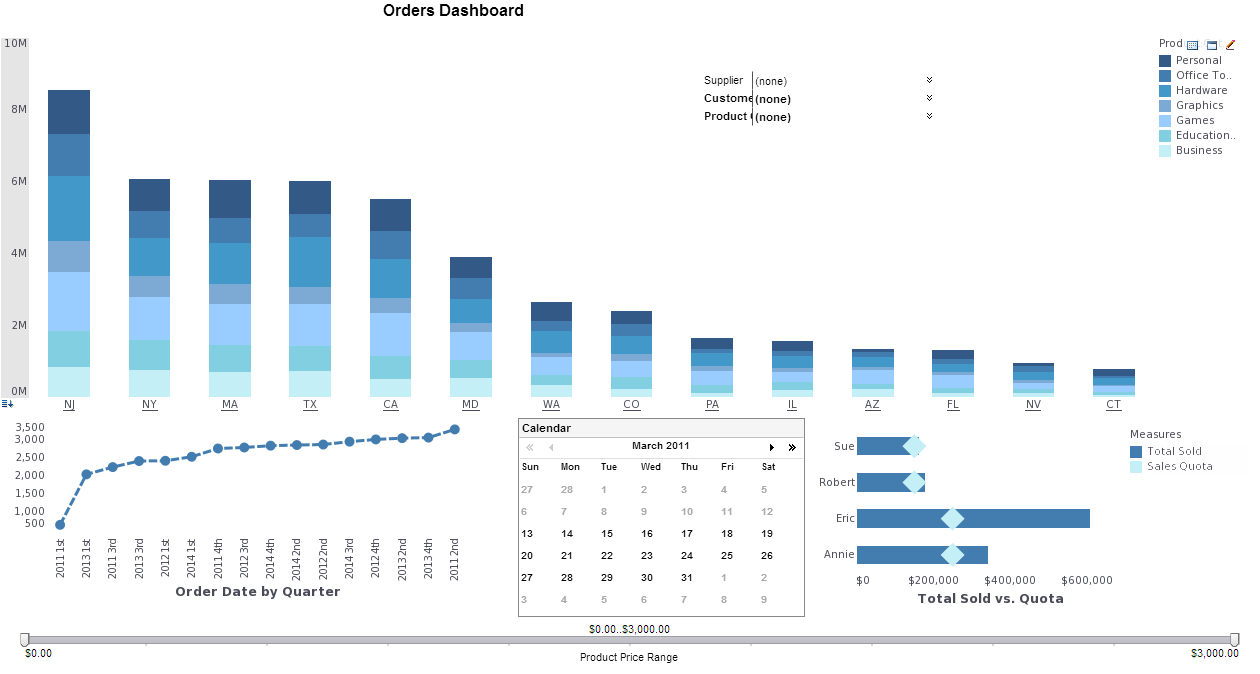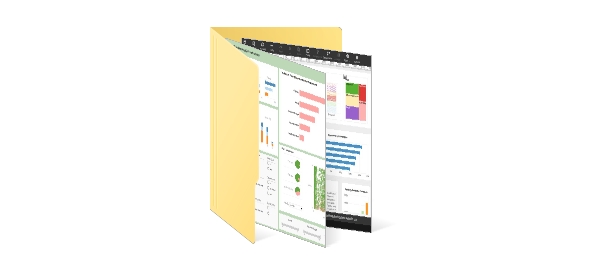Orders Analysis Dashboard
The Orders Analysis Dashboard below is an example of an interactive web-based analytical dashboard built using InetSoft's software that could be used by a supplier in any industry. This particular chart allows users to track and analyze sales orders of different industries. With a easy-to-use point and click environment, users can also drill down into orders by geography, different suppliers, and/or specific industries for an even more accurate analysis.
With InetSoft's drag and drop design tools, suppliers can quickly build productive analytical tools like this one that monitors and visualizes order statistics from multi-dimensional perspectives to aid users in day-to-day operations, as well as help them keep track of and achieve long term goals and objectives.
Capabilities of the InetSoft's Orders Analysis Dashboard Example
- Monitor, explore, and analyze by filtering and sorting desired information
- Easy to use, modify, and create charts and visuals
- Leverage user-driven data mashup
- Upload and sift through multi-dimensional data to spot trends and aberrations
- Slice and dice data with simple point-and-click method
- Share visual analysis with others
Very Interesting Findings from Doing Order Analysis for an Online Retailer of Inflatable Furniture
Inflatable furniture represents a unique niche in the online retail market, encompassing products such as air mattresses, inflatable chairs, loungers, pools, and novelty items. While it may seem like a simple category, an online retailer of inflatable furniture can uncover a wealth of insights by conducting thorough order analysis. By examining purchasing patterns, seasonality, customer behavior, and geographic trends, the retailer can optimize inventory, refine marketing strategies, and improve overall operational efficiency. Order analysis provides not just historical sales data but also predictive insights that allow the business to anticipate demand and respond proactively to shifts in consumer preferences.
One of the first insights revealed through order analysis is seasonality in demand. Inflatable furniture, particularly pool floats, loungers, and summer-themed items, experiences strong spikes during warmer months. Analyzing orders by month, week, or even day of the week allows the retailer to anticipate these spikes and ensure sufficient inventory. Interestingly, some products, such as inflatable beds or chairs for temporary accommodations, may see consistent demand year-round, while novelty items like inflatable holiday decorations peak around specific holidays. Understanding these seasonal patterns allows the retailer to plan promotions, adjust stock levels, and optimize warehouse space efficiently.
Geographic trends are another fascinating outcome of order analysis. By mapping customer locations and correlating them with order data, the retailer can identify regions with high sales concentration. For instance, beach towns and resort areas may show higher purchases of inflatable loungers and pool toys, while urban regions might purchase more space-saving air mattresses or foldable inflatable chairs. This information is invaluable for targeted marketing campaigns, localizing inventory distribution, and planning region-specific promotions. Additionally, understanding delivery trends by geography helps optimize shipping routes, reduce costs, and improve delivery times, enhancing customer satisfaction.
Customer behavior analysis provides deeper insights into purchasing patterns. By examining repeat purchases, order frequency, and basket size, the retailer can identify loyal customers and high-value segments. Some customers may consistently buy inflatable furniture for seasonal events or rentals, indicating potential for subscription services or loyalty programs. Analyzing the combination of items purchased together also reveals cross-selling opportunities. For example, customers buying inflatable beds may also purchase repair kits, air pumps, or protective covers, allowing the retailer to bundle products effectively and increase average order value.
Another interesting finding from order analysis is the impact of pricing strategies on sales performance. By evaluating how different pricing tiers, discounts, and promotional campaigns affect order volume, the retailer can identify optimal pricing strategies for various product lines. Some inflatable furniture items may show price elasticity, where minor discounts significantly increase sales volume, while others may demonstrate inelastic behavior, with consistent demand regardless of price fluctuations. Dynamic pricing models can be developed using these insights to maximize revenue while maintaining competitiveness in a crowded online marketplace.
Order analysis also uncovers insights into the effectiveness of marketing channels. By linking orders to acquisition sources such as search engine traffic, social media campaigns, email marketing, or influencer promotions, the retailer can determine which channels generate the highest conversion rates. For example, a spike in sales of inflatable pool toys may coincide with summer influencer campaigns on social media platforms. By identifying the channels that drive high-value orders, the retailer can allocate marketing budgets more efficiently and craft campaigns that resonate with target audiences.
Inventory management and supply chain optimization are further areas where order analysis provides actionable insights. Historical order data can be used to forecast demand for each product SKU, reducing the risk of overstock or stockouts. Predictive analytics models may reveal that certain products, such as high-demand inflatable loungers, require more frequent replenishment during summer months. Additionally, analyzing order fulfillment times and shipping delays allows the retailer to optimize warehouse operations, improve supplier coordination, and enhance the overall customer experience. For example, identifying consistently delayed SKUs can prompt renegotiation with suppliers or changes in warehouse layout to expedite picking and packing processes.
Customer segmentation derived from order analysis can yield surprising patterns. Data may reveal that certain demographic groups purchase inflatable furniture for niche uses, such as college students buying air mattresses for dorms, event planners purchasing inflatable seating for parties, or outdoor enthusiasts using inflatable loungers for camping. Segmenting customers by demographics, purchase frequency, and product preference enables personalized marketing, product recommendations, and targeted promotions, increasing engagement and conversion rates. Furthermore, it may reveal under-served segments, opening opportunities for new product introductions or tailored advertising campaigns.

Analyzing return patterns provides another layer of insight. Inflatable furniture can be prone to defects, punctures, or sizing issues, and order analysis helps identify products with high return rates. By correlating returns with product types, suppliers, or shipping methods, the retailer can take corrective action, such as improving product quality, modifying packaging, or updating product descriptions. Understanding the reasons behind returns also helps refine the product catalog, ensuring that high-quality, low-return items are prominently featured and promoted. This proactive approach reduces operational costs associated with returns and enhances customer satisfaction.
Time-of-day and day-of-week ordering patterns are yet another interesting finding. Online retailers often discover that customer orders cluster around specific times, such as evenings or weekends, when customers have free time to browse and make purchases. For instance, orders for inflatable pool toys might spike on Friday afternoons or early Saturday mornings, aligning with weekend plans. Leveraging these insights, the retailer can schedule marketing emails, push notifications, or social media ads to coincide with peak ordering periods, increasing engagement and conversion rates.
Finally, order analysis can reveal broader trends in consumer behavior and product evolution. Tracking the popularity of new designs, materials, or color options over time allows the retailer to understand emerging preferences. For instance, glow-in-the-dark inflatable furniture or eco-friendly, biodegradable products may see increasing demand. By continuously analyzing order trends, the retailer can make informed decisions about product development, discontinuing low-performing SKUs, and introducing innovative products that align with customer interests and market trends.


